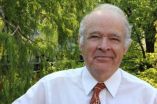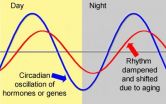(Press-News.org) (PHILADELPHIA) – Research derived from early national experience of liver transplantation has shown that deceased donor liver transplants offered recipients better survival rates than living donor liver transplants, making them the preferred method of transplantation for most physicians. Now, the first data-driven study in over a decade disputes this notion. Penn Medicine researchers found that living donor transplant outcomes are superior to those found with deceased donors with appropriate donor selection and when surgeries are performed at an experienced center. The research is published this week in the journal Hepatology.
Lead author David Goldberg, MD, MSCE, and colleagues in the Perelman School of Medicine at the University of Pennsylvania examined national transplant data from Organ Procurement and Transplant Network (OPTN)/United Network for Organ Sharing (UNOS) between 2002 to 2012 to compare outcomes in deceased donor transplants with those of living donor liver transplant recipients.
Of the 2,103 living donor transplant and 46,674 deceased donor transplants recipients analyzed, the three-year patient survival rate for deceased donor recipients was 78 percent compared with 83 percent for living donor transplants that were performed at experienced centers. The difference in survival became even greater with longer follow-up, with a five-year survival rate of 71 percent for deceased donor recipients, compared with 78 percent for living donor transplants at an experienced center.
"With a scarcity of organs and an ever growing need, living donor transplants are underused and can alleviate long transplant wait lists while decreasing waiting list mortality, with outcomes that can be as good, and when performed at an experienced center, potentially better for living donor recipients," says Goldberg. "Every year 20 to 30 percent of patients die waiting for a new liver."
The team found that those patients with cases complicated by autoimmune hepatitis or cholestatic liver disease had the greatest survival benefit compared with deceased donors when they received a living donor transplant performed at an experienced center.
The paper defined an experienced transplant center as one that had performed at least 15 adult-to-adult living donor liver transplants. There are 36 transplant centers in the U.S. who perform living donor liver transplants, with Penn as one of only 16 to have performed more than 60 adult living donor liver transplants since 2002.
Further, the Penn researchers developed a novel scoring system for living donor transplant recipients that considers several donor and recipient variables to help predict post-transplant outcomes. This score, which requires further validation, can rank recipients in high, intermediate and low-risk groups. They believe risk stratification can help identify optimal donor and recipient matches which can lead to better outcomes and can be used to counsel waitlisted patients considering living donor transplantation. It can also provide objective criteria for donor selection.
Using this, the team found that three-year survival rates for the best matched/lowest risk donor and recipient pairs could be greater than 87 percent and less than 74 percent for the worst-matched/highest-risk group.
"Living donor liver transplantation can be performed at an earlier stage than deceased donor transplantation, before a patient's clinical condition deteriorates," says the study's senior author, Abraham Shaked, MD, PhD, professor of Surgery and director of the Penn Transplant Institute. "Given this, and the superior outcomes, we urge our patients to consider living donor transplantation as the procedure of choice provided they are a suitable candidate for a living donor transplant, have an appropriate donor, and have the procedure performed at an experienced center such as Penn."
Significant improvement was seen in mortality rates for living donor transplant recipients with the passage of time: the three-year survival rate for living donor recipients was 64 percent in 1999 and had improved to 82 percent by 2008.
"Living donor transplants currently represent just three to four percent of liver transplants," says Goldberg. "We expect to see a renewed focus on these as surgical techniques and surgical experience with living donor transplants continues to increase, mortality rates improve and greater evidence exists showing the benefit of living donor liver transplant surgeries."
INFORMATION:
Additional Penn authors on the study include Benjamin French, PhD; Peter Abt, MD; and Kim Olthoff, MD.
This work was funded by NIH grant K08 DK098272.
Penn Medicine is one of the world's leading academic medical centers, dedicated to the related missions of medical education, biomedical research, and excellence in patient care. Penn Medicine consists of the Raymond and Ruth Perelman School of Medicine at the University of Pennsylvania (founded in 1765 as the nation's first medical school) and the University of Pennsylvania Health System, which together form a $4.3 billion enterprise.
The Perelman School of Medicine has been ranked among the top five medical schools in the United States for the past 17 years, according to U.S. News & World Report's survey of research-oriented medical schools. The School is consistently among the nation's top recipients of funding from the National Institutes of Health, with $392 million awarded in the 2013 fiscal year.
The University of Pennsylvania Health System's patient care facilities include: The Hospital of the University of Pennsylvania -- recognized as one of the nation's top "Honor Roll" hospitals by U.S. News & World Report; Penn Presbyterian Medical Center; Chester County Hospital; Penn Wissahickon Hospice; and Pennsylvania Hospital -- the nation's first hospital, founded in 1751. Additional affiliated inpatient care facilities and services throughout the Philadelphia region include Chestnut Hill Hospital and Good Shepherd Penn Partners, a partnership between Good Shepherd Rehabilitation Network and Penn Medicine.
Penn Medicine is committed to improving lives and health through a variety of community-based programs and activities. In fiscal year 2013, Penn Medicine provided $814 million to benefit our community.
Transplant patients who receive livers from living donors more likely to survive
Penn Study Points to better outcomes for living donor recipients who have surgery at experienced transplant centers
2014-07-17
ELSE PRESS RELEASES FROM THIS DATE:
GW researcher unlocks next step in creating HIV-1 immunotherapy using fossil virus
2014-07-17
WASHINGTON (July 17, 2014) — The road to finding a cure for HIV-1 is not without obstacles. However, thanks to cutting-edge research by Douglas Nixon, M.D., Ph.D., and colleagues, performed at the George Washington University (GW), Oregon Health & Science University, the University of Rochester, and UC San Francisco, the scientific community is one step closer to finding a viable immunotherapy option for HIV-1, using an immune attack against a fossil virus buried in the genome.
A major hurdle in eradicating HIV-1 has been outsmarting the frequent mutations, or changing ...
Oregon geologist says Curiosity's images show Earth-like soils on Mars
2014-07-17
EUGENE, Ore. -- Soil deep in a crater dating to some 3.7 billion years ago contains evidence that Mars was once much warmer and wetter, says University of Oregon geologist Gregory Retallack, based on images and data captured by the rover Curiosity.
NASA rovers have shown Martian landscapes littered with loose rocks from impacts or layered by catastrophic floods, rather than the smooth contours of soils that soften landscapes on Earth. However, recent images from Curiosity from the impact Gale Crater, Retallack said, reveal Earth-like soil profiles with cracked surfaces ...
Is the universe a bubble? Let's check
2014-07-17
Never mind the big bang; in the beginning was the vacuum. The vacuum simmered with energy (variously called dark energy, vacuum energy, the inflation field, or the Higgs field). Like water in a pot, this high energy began to evaporate – bubbles formed.
Each bubble contained another vacuum, whose energy was lower, but still not nothing. This energy drove the bubbles to expand. Inevitably, some bubbles bumped into each other. It's possible some produced secondary bubbles. Maybe the bubbles were rare and far apart; maybe they were packed close as foam.
But here's the thing: ...
Orthopedic surgery generally safe for patients age 80 and older
2014-07-17
ROSEMONT, Ill.─Over the past decade, a greater number of patients, age 80 and older, are having elective orthopaedic surgery. A new study appearing in the Journal of Bone and Joint Surgery (JBJS) found that these surgeries are generally safe with mortality rates decreasing for total hip (THR) and total knee (TKR) replacement and spinal fusion surgeries, and complication rates decreasing for total knee replacement and spinal fusion in patients with few or no comorbidities (other conditions or diseases).
"Based on the results of this study, I think very elderly patients, ...
Study led by indigenous people uncovers grizzly bear 'highway'
2014-07-17
A novel, First Nations-led research collaboration has revealed a previously undocumented grizzly bear aggregation in coastal British Columbia, one of the most southerly aggregations of salmon-feeding grizzlies in North America. Using non-invasive DNA analysis, the authors describe a grizzly bear "highway," identifying nearly 60 individual bears, many who travelled hundreds of miles from surrounding areas to feed on autumn-spawning salmon in the Koeye River. The research was guided by the customary law and cultural practices of the Heiltsuk First Nation and recently published ...
Lipoic acid helps restore, synchronize the 'biological clock'
2014-07-17
CORVALLIS, Ore. – Researchers have discovered a possible explanation for the surprisingly large range of biological effects that are linked to a micronutrient called lipoic acid: It appears to reset and synchronize circadian rhythms, or the "biological clock" found in most life forms.
The ability of lipoic acid to help restore a more normal circadian rhythm to aging animals could explain its apparent value in so many important biological functions, ranging from stress resistance to cardiac function, hormonal balance, muscle performance, glucose metabolism and the aging ...
How the brain stabilizes its connections in order to learn better
2014-07-17
Throughout our lives, our brains adapt to what we learn and memorise. The brain is indeed made up of complex networks of neurons and synapses that are constantly re-configured. However, in order for learning to leave a trace, connections must be stabilized. A team at the University of Geneva (UNIGE) discovered a new cellular mechanism involved in the long-term stabilization of neuron connections, in which non-neuronal cells, called astrocytes, play a role unidentified until now. These results, published in Current Biology, will lead to a better understanding of neurodegenerative ...
NASA's Aqua satellite sees birth of Tropical Depression 10W
2014-07-17
The tenth tropical depression of the Northwestern Pacific Ocean was born as NASA's Aqua satellite passed overhead.
NASA's Aqua satellite passed over Tropical Depression 10W on July 17, as it came together northwest of the island of Yap. As Aqua passed overhead the Atmospheric Infrared Sounder (AIRS) instrument aboard captured infrared data that showed powerful thunderstorms developed around the storm's center. When AIRS gathered the data on the cloud tops, the temperatures were already as cold as -63F/-52C, indicating strong uplift has pushed them to the top of the troposphere.
At ...
NASA's TRMM satellite adds up Typhoon Rammasun's Philippines deluge
2014-07-17
Typhoon Rammasun dropped large amounts of rainfall over the Philippines, and the TRMM satellite was used to measure it from space. Rammasun is now making its way toward Hainan Island, China.
NASA and the Japanese Aerospace Exploration Agency partner on the Tropical Rainfall Measuring Mission or TRMM satellite. As TRMM orbits the Earth it has the ability to calculate rainfall occurring in storms and a rainfall analysis using TRMM and other data helps scientists calculate total rainfall.
A preliminary analysis of rainfall during the period when typhoon Rammasun was moving ...
Scientists track gene activity when honey bees do and don't eat honey
2014-07-17
CHAMPAIGN, Ill. — Many beekeepers feed their honey bees sucrose or high-fructose corn syrup when times are lean inside the hive. This practice has come under scrutiny, however, in response to colony collapse disorder, the massive -- and as yet not fully explained -- annual die-off of honey bees in the U.S. and Europe. Some suspect that inadequate nutrition plays a role in honey bee declines.
In a new study, described in Scientific Reports, researchers took a broad look at changes in gene activity in response to diet in the Western honey bee (Apis mellifera), and found ...
LAST 30 PRESS RELEASES:
Alexander Khalessi, MD, MBA, appointed Chief Innovation Officer
Optical chip pioneers physical-layer public-key encryption with partial coherence
How your brain understands language may be more like AI than we ever imagined
Missed signals: Virginia’s septic strategies overlook critical timing, study warns
Delayed toxicities after CAR T cell therapy for multiple myeloma are connected and potentially preventable
Scientists find cellular key to helping plants survive in saltwater
Medical cannabis program reduces opioid use
Immunotherapy works for sepsis thanks to smart patient selection
Cardiovascular events 1 year after RSV infection in adults
US medical prices and health insurance premiums, 1999-2024
Medical cannabis and opioid receipt among adults with chronic pain
Multichannel 3D-printed bioactive scaffold combined with siRNA delivery for spinal cord injury recovery
Triaptosis—an emerging paradigm in cancer therapeutics
A new paradigm in spectroscopic sensing: The revolutionary leap of SERS-optical waveguide integration and ai-enabled ultra-sensitive detection
Sweet tooth: How blood sugar migration in diabetes affects cavity development
Lowest suicide rate is in December but some in media still promote holiday-suicide myth
Record-breaking cosmic explosion challenges astronomers’ understanding of gamma-ray bursts
Excessive heat harms young children’s development, study suggests
Quanta Books to publish popular math and physics titles by Terence Tao and David Tong
Philanthropic partnerships fund next-generation instruments for mid-sized telescopes
AI offers ‘roadmap’ to plant genetics
Myosin XI-1: A key molecular target for salt-tolerant crops
Pusan National University study highlights the health hazards of ultrafine particles from small home appliances with electric heating coils and brushed DC motors
Global first: New Indigenous-led research initiative to revitalize legal orders
Transforming acoustic waves with a chip
When climate risk hits home, people listen: Study reveals key to engagement with disaster preparedness messaging
Major breakthrough against diabetes thanks to a microbial molecule that disarms inflammation
Silicon chips on the brain: Researchers announce a new generation of brain-computer interface
Getting rest is the best
Towards sustainable organic synthesis – Mechanochemistry replaces lithium with sodium in organic reactions
[Press-News.org] Transplant patients who receive livers from living donors more likely to survivePenn Study Points to better outcomes for living donor recipients who have surgery at experienced transplant centers






